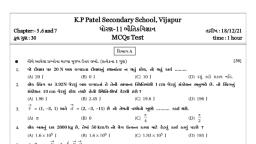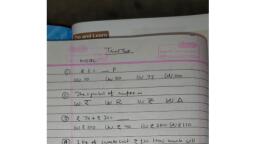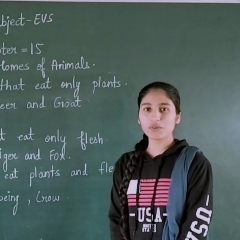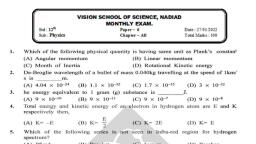Question 3 :
Due to refraction, when seen from outside,a coin placed under water in a bowl, appears to
Question 4 :
A student obtained a sharp inverted image of a distant tree on a screen placed in front of the concave mirror. He then removed the screen and tried to look into the mirror. He would now see:
Question 5 :
If the refractive index of medium $b$ with respect to medium $a$ and that of medium $c$ with respect to medium b are given, then the refractive index of a medium $c$ with respect to a medium $a$ can be found by using the relation<br/>$n_{ca}\, =\, n_{ba}\, \times\, ........$<br/><br/>
Question 6 :
During refraction through a glass block, the angle of refraction _______.
Question 7 :
Assertion: If refractive index of one medium is equal to refractive index of second medium, then beam does not bend at all.
Reason: The bending of light does not depend on refractive indices of media.
Question 8 :
State whether true or false.<br/>A convex mirror always forms a real image.
Question 10 :
A convex lens makes a real image $4\ cm$ long on a screen. When the lens is shifted to a new position without disturbing the object, we again get a real image on the screen which is $16\ cm$ tall. The length of the object must be
Question 11 :
A ray of light travelling in air strikes the surface of glass at angle of $45^{\circ}$. The angle of refraction in the glass will be :
Question 12 :
A beam of light passing from air enters into the glass. Identify which of the following statements is true?<br/>
Question 14 :
Fill in the blank. A _____ is a piece of transparent glass bounded by two spherical surfaces. 
Question 15 :
The frequency of a light wave in a material is $2\times 10^{14} Hz$ and wavelength is $5000\overset {\circ}{A}$. The refractive index of material will be :
Question 16 :
The power of two convex lenses $A$ and $B$ are $8$ diopters and $4$ diopters respectively. If they are to be used as a simple microscope, the magnification of
Question 17 :
Various optical instruments like telescopes, microscopes, camera uses which property of light?<br>
Question 18 :
Object when placed at ________ in front of concave mirror magnification of -1 is obtained.
Question 20 :
Which of the following is not a use of concave lens?
Question 22 :
The focal length of a concave lens is $2m$. Then the power of the lens is:<br/>
Question 23 :
The focal length of a combination of lenses formed with lenses having powers of $+2.50\ D$ and $-3.75\ D$ will be
Question 24 :
State whether true or false : The degree of convergence of divergence of light rays achieved by a lens is expressed in terms of its power.
Question 25 :
Two thin lenses of focal lengths $f_{1} and f_{2}$ are in contact and coaxial. The power of the combination is :<br/>
Question 26 :
A ray of light is incident on the surface of transparent medium at an angle of $45^o$ and is refracted in the medium at an angle of $30^o$. What will be the velocity of light in the transparent medium ? <br/>
Question 27 :
The power of a lens whose focal length is one metre is ______ dioptre.
Question 28 :
The power of a lens being $+4$ dioptres suggests that it is a
Question 29 :
An object is placed somewhere in front of concave mirror. The focal length of the mirror is $10.0 cm$. The image for this object CANNOT be formed in which of the following locations?
Question 30 :
Which of the following mirrors forms an image which is virtual and smaller in size?
Question 33 :
A virtual image larger than the object can be produced by a
Question 34 :
When a drop of oil is spread on a water surface, it displays beautiful colours in daylight because of :
Question 36 :
The ratio of the sine of angle  of incidence to the sine of angle of refraction is a constant for :
Question 37 :
A short sighted person can see distinctly only those objects which lie between $10cm$ and $100cm$ from him, The power of the spectacle lens required to see a distance object is
Question 38 :
When a ray of light passes from an optically less dense medium to a more dense medium, it :
Question 41 :
Which of the following is not a characteristic of image formed by a Concave lens ?
Question 43 :
If a $3cm$ tall object placed perpendicular to principal axis of a convex lens of focal length $15cm$ produces a real invented image of height $15cm$, then its object distance $(u)$ is ................ and image distance $(v)$ is ................
Question 44 :
When a ray of light passes through a rectangular slab, made up of some transparent material other than glass, the emergent ray is
Question 45 :
To construct a ray diagram, you need a minimum of  _______ ray(s) whose path(s) after refraction through the lens are known.
Question 46 :
The image formed by a concave mirror is observed to be virtual, erect and larger than the object. Where should be the position of the object?
Question 47 :
A ray of light incident at the optical centre of lens, passes undeviated after refraction.<br>
Question 48 :
A thin film of thickness i and index of refraction 1.33 coats a glass with index of refraction 1.50. What is the least thickness/that will strongly reflect light with wavelength 600 nm incident normally?
Question 49 :
The radius curvature for a convex lens is $40\ cm$, for each surface. Its refractive index is $1.5$. The local length will be
Question 50 :
A real, inverted and equal in size image is formed by
Question 51 :
Fine beam of light entering through a small hole in a dark room illuminates the particles in its path. Identify the effect associated with this process.<br/>
Question 59 :
What are the colours of the Sun observed most during sunrise/sunset and noon? <br/>
Question 60 :
If the image of distant objects is formed in front of the retina, the defect of vision may be
Question 61 :
Why do high rise buildings have a red light on the top of the building?
Question 62 :
The rising and setting of sun appear red because of : 
Question 63 :
Fine beam of light entering through a small hole in a dark room illuminates the particles in its path. Identify the effect associated with this process.<br/>
Question 64 :
State whether true or false :Myopia is caused due to the high converging power of the eye lens.
Question 65 :
Which of the following quantities changes during the process of scattering?
Question 66 :
The danger signals installed at the top of tall buildings are red in colour. These can be easily seen from a distance because among all other colours, the red light:<br/>
Question 67 :
The split of white light into its constituent colours by a triangular prism is called ________ .<br/>
Question 69 :
Why do high rise buildings have a red light on the top of the building?
Question 71 :
The path of a beam of light is invisible in which solution?
Question 74 :
Which colour of light is scattered the most(maximum) in the atmosphere?
Question 78 :
The bluish colour of water in deep sea is due to:<br/>
Question 79 :
For the myopic eye, the far point is farther away than the normal.
Question 80 :
Which of the following phenomena contributes significantly to the reddish appearance of the sun at sunrise or sunset?<br/>
Question 85 :
In the white light of sun, maximum scattering by the air molecules present in the earth's atmosphere is for:<br>
Question 87 :
The path of beam of light becomes _____ in a colloidal solution.
Question 88 :
An astronaut in a spaceship the sky appears black due to:
Question 89 :
The sun appears red at the time of sun-rise and sun-set. This is because:
Question 92 :
Which of the following lens is used to minimise hypermetropia ?
Question 93 :
The danger signals installed at the top of tall buildings are red in colour. These can be easily seen from a distance because among all other colours, the red light:<br/>
Question 95 :
The dispersion of white light occurs because the angle of....................... of different colours is different when passing through the glass prism.
Question 96 :
Which of the following lens is used to minimise myopia ?
Question 97 :
The least distance of distinct vision for a defective eye is $75$ cm. What should be the focal length of the lens which will be used to read a book clearly at $25$ cm?
Question 100 :
In context of scatteringFine particles : ____ wavelength : : large particles : _____ wavelength



























